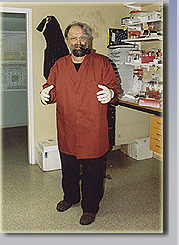



Reseach areas of our group
Phylogeographic context of human maternal and paternal lineages
The topology of human mitochondrial tree and the origin and diversity of modern human populations
Introductory remarks regarding molecular evolution and human mitochondrial DNA and Y-chromosomal studies
Introduction To address the question "Where did we come from?" in contemporary world scientists use different ways - the methods of linguistics, physical anthropology, and archaeology. The molecular anthopolgy is therefore a multidiciplinary field - resently established term 'archaeogenetics' should reveal its best essense. The parts of human genome we are using in our studies are selected on three main criteria:
1. relatively fast mutation rate
2. inherited uniparentally
3. do not recombine
In mammals these criteria apply to mitochondrial DNA and to the nonrecombining part of Y-chromosome. Every person inherits its mitochondrial genome from his/her mother. The Y-chromosome is only transmitted from father to son. The ideological bases for reconstructing the evloutionary events using the genetic variation dates back into 1962 when Linus Pauling and Emile Zuckerkandl proposed the existence of molecular evolutionary clock or just molecular clock. Mutation in our genome occur at regular rate, however, the rate is not homogenuous in different regions of our genome. Those mutations can be beneficial of fatal, but mostly neutral for the phenotype. Therefore, those mostly neutral mutations accumulate and the population diversifies during many generations.
mitochondrial DNA About the same time, in the middle of 1960ties, the DNA in chicken and yeast mitochondria was discovered (Nass and Nass 1963, Schatz et al. 1964). Since 1981, after the sequencing the human mitochondrial genome, the firm ground for further studies was established. The 'Out of Africa' hypothesis as the main step in mtDNA studies of mid 1980ties, by Rebecca Cann and coworkers, was still under frequent discussion until the end of 20th century. The first part of the 1990ties was a period for studing the restriction fragment length polymorphism (RFLP) among different populations. At the same time sequencing efforts started to develop faster, and the data about first hypervariable segment (HVS-I) of D-loop of mtDNA began to accumulate. The second half of 1990ties brought enlightment into the real topology of the global mitochondrial DNA tree, as the RFLP data from the coding region and D-loop data were combined (Torroni et al. 1996). The beginning of the 21. century has brought us a new era - large amounts of complete mtDNA sequences, clarifying the topology of the tree (Finnilš et al. 2001, Maca-Meyer et al. 2001, Herrnstadt et al. 2002), and giving more information about the 'ticking rate' of molecular clock.
Y-chromosome DNA variation studies for Y-chromosome orginate since mid 1980ties when first RFLP markers were established. Many RFLP markers were discovered during the following ten years. In the beginning of 1990ties researchers started to use pulse field gel electrophoresis (PFGE) for variation analysis. In 1995 a method for discovery of new mutations was used on Y-chromosome (Underhill, Oefner et al. 1995). This method is still in wide use around the globe for determining the new polymorphic sites in genome. During the second half of the 1990ties new type of mutations were studied - these involved many microsatellites, several minisattelites, large insertions/deletions, and pointmutations. At the same time several different nomencatures and phylogenetic trees were developed. Recently most of these different approaches were unified by Y-chromosome consortium, and the further work in this respect relies on the clarifying of the topology of this tree. The beginning of 21. century is going to be the era of full genomic sequences, but in case of the Y-chromosome there is still long way to go, before we will have the detailed information about complete Y-chromosome and its diversity.






